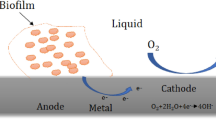Abstract
We introduce a low-cost and effective technique that can transform waste cement-based dust into a superhydrophobic coating with dirt pickup resistance. An organic-inorganic hybrid superhydrophobic coating is prepared by the sol-gel method using methyltriethoxysilane as a precursor and waste cement-based dust as a film-forming material. Orthogonal experiments and a comprehensive scoring method were used to optimize the composition and production technologies. Our results show that this superhydrophobic organic-inorganic hybrid coating has an average static contact angle of 151.65° and low water adhesion. Related tests reveal that the dirt pickup resistance, washing resistance and film-substrate cohesion of this coating are also outstanding. The multi-scale physical and chemical mechanisms behind the properties of the coating are investigated. This recycled cement-based coating can be used as the external cover of engineering structures to protect them from corrosion.
Similar content being viewed by others
References
Lee C, Kim C J. underwater restoration and retention of gases on superhydrophobic surfaces for drag reduction. Phys Rev Lett, 2011, 106: 014502
Yao X, Song Y L, Jiang L. Applications of bio-inspired special wettable surfaces. Adv Mater, 2011, 23: 719–734
Li Y, Li L, Sun J G. Bioinspired self-healing superhydrophobic coatings. Angew Chem Int Edit, 2010, 49: 6129–6133
Kulinich S A, Farhadi S, Nose K, et al. Superhydrophobic surfaces: Are they really ice-repellent? Langmuir, 2011, 27: 25–29
Nakajima A, Fujishima A, Hashimcto K, et al. Preparation of transparent superhydrophobic boehmite and silica films by sublimation of aluminum acetylacetonate. Adv Mater, 1999, 11: 1365–1368
Nahum T, Dodiuk H, Dotan A, et al. Superhydrophobic durable coating based on UV-photoreactive silica nanoparticles. J Appl Polym Sci, 2014, 131: 41122
Sun T, Feng L, Gao X, et al. Bioinspired surfaces with special wettability. Acc Chem Res, 2005, 38: 644
Gao L C, Fadeev A Y, McCarthy T J. Superhydrophobicity and contact-line issues. MRS Bull, 2008, 33: 747–751
Zhang J H, Sheng X L, Jiang L. The dewetting properties of lotus leaves. Langmuir, 2009, 25: 1371–1376.
Liu M J, Zheng Y M, Zhai J, et al. bioinspired super-antiwetting interfaces with special liquid-solid adhesion. Acc Chem Res, 2010, 43: 368–377
Manukyan G, Oh J M, van den Ende D, et al. Electrical switching of wetting states on superhydrophobic surfaces: A route towards reversible cassie-to-wenzel transitions. Phys Rev Lett, 2011, 106: 014501
Nosonosky M, Bhushan B. Artificial (Biomimetic) Superhydrophobic Surface. Multi-scale Dissipative Mechanisms and Hierarchical Surfaces: Friction, Superhydrophobicity, and Biomimetics. Heidelberg: Springer Press, 2008. 199
Chen W, Fadeev A Y, Heieh M C, et al. Ultrahydrophobic and ultralyophobic surfaces: Some comments and examples. Langmuir, 1999, 15: 3395–3399
Bico J, Marzolin C, Quere D. Pearl drops. Europhys Lett, 1999, 47: 220–226
Nakajima A, Abe K, Hashimoto K, et al. Preparation of hard super-hydrophobic films with visible light transmission. Thin Solid Films, 2000, 376: 140–143
Liang X Z, Wang H. Experimental research on roadway filling with skeleton type based on construction waste. Metal Mine, 2011, 11: 62
Yang H, Pi P H, Cai Z Q. Facile preparation of super-hydrophobic and super-oleophilic silica film on stainless steel mesh via sol-gel process. Appl Surf Sci, 2010, 256: 4095–4102
Latthe S S, Dhere S L, Kappenstein C, et al. Sliding behavior of water drops on sol-gel derived hydrophobic silica films. Appl Surf Sci, 2010, 256: 3259–3264
Latthe S S, Imai H, Ganesan V, et al. Porous superhydrophobic silica films by sol-gel process. Micropor Mesopor Mater, 2010, 130: 115–121
Liu X M, He J H. Superhydrophilic and antireflective properties of silica nanoparticle coatings fabricated via layer-by-layer assembly and postcalcination. J Phys Chem C, 2009, 113: 148–152
Fadeev A Y, McCarthy T J. Self-assembly is not the only reaction possible between alkyltrichlorosilanes and surfaces: Monomolecular and oligomeric covalently attached layers of dichloro- and trichloroalkylsilanes on silicon. Langmuir, 2000, 16: 7268–7274
Hong X, Gao X, Jiang L. Application of superhydrophobic surface with high adhesive force in no lost transport of superparamagnetic microdroplet. J Am Chem Soc, 2007, 129: 1478–1479
Ishida N, Inoue T, Miyahara M, et al. Nanobubbles on a hydrophobic surface in water observed by tapping-mode atomic force microscopy. Langmuir, 2000, 16: 6377–6380
Author information
Authors and Affiliations
Corresponding author
Rights and permissions
About this article
Cite this article
Guo, L., Sun, W., Yu, T. et al. Preparation and characteristics of a recycled cement-based superhydrophobic coating with dirt pickup resistance. Sci. China Technol. Sci. 58, 1096–1104 (2015). https://doi.org/10.1007/s11431-015-5804-5
Received:
Accepted:
Published:
Issue Date:
DOI: https://doi.org/10.1007/s11431-015-5804-5




